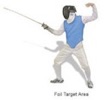About Fencing












The 3 Weapons
Épée, Foil and Saber are the three weapons used in the sport of fencing. Each weapon has it’s own fencing style, specific rules and is only fenced against itself. You can’t, for example, use an épée to fence against someone with a foil. Fencers typically try all three weapons but tend to prefer one.
1:01 PM

Épée
The épée (pronounced "EPP-pay"), is the descendant of the dueling sword. It is the heaviest of the three weapons, has a larger guard (to protect the hand,) and a stiff blade. Touches are scored only with the point of the blade but the entire body is valid target area. In épée, the fencer who touches first scores, but both fencers score a touch if they hit at the exact same time.
Saber
The saber is the modern version of the cavalry sword, and is similar in weight to the foil, but points can be scored using the edge of the blade, not just the point. The target area is from the hips to the top of the head, simulating the cavalry rider on a horse. Saber fencing uses the conventions of right-of-way to determine priority if both fencers hit at the same time.
Foil
The foil is light, has a small hand guard, and has a flexible rectangular blade. Points are scored with the tip of the blade, and must land within the torso of the body. Foil fencing uses the conventions of right-of-way to determine priority if both fencers hit at the same time.






Foothills Fencing Academy has many recreational and competitive fencers in all three weapons. We’re proud of the fact that no matter which weapon you fence, you’ll have friendly, experienced partners to bout with.



